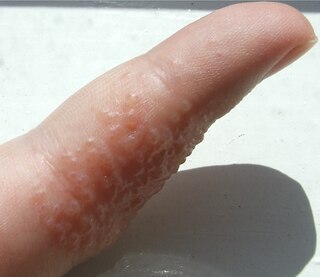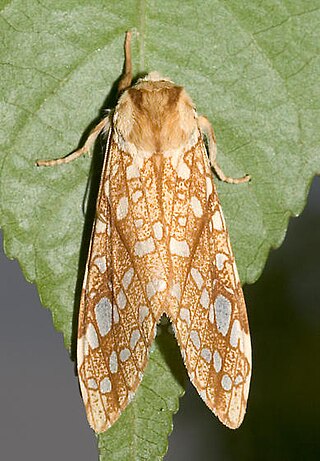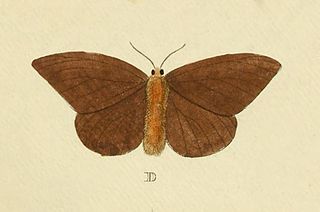Related Research Articles

Dermatitis is inflammation of the skin, typically characterized by itchiness, redness and a rash. In cases of short duration, there may be small blisters, while in long-term cases the skin may become thickened. The area of skin involved can vary from small to covering the entire body. Dermatitis is often called eczema, and the difference between those terms is not standardized.

Contact dermatitis is a type of acute or chronic inflammation of the skin caused by exposure to chemical or physical agents. Symptoms of contact dermatitis can include itchy or dry skin, a red rash, bumps, blisters, or swelling. These rashes are not contagious or life-threatening, but can be very uncomfortable.

Rosacea is a long-term skin condition that typically affects the face. It results in redness, pimples, swelling, and small and superficial dilated blood vessels. Often, the nose, cheeks, forehead, and chin are most involved. A red, enlarged nose may occur in severe disease, a condition known as rhinophyma.
Antipruritics, abirritants, or anti-itch drugs, are medications that inhibit the itching often associated with sunburns, allergic reactions, eczema, psoriasis, chickenpox, fungal infections, insect bites and stings like those from mosquitoes, fleas, and mites, and contact dermatitis and urticaria caused by plants such as poison ivy or stinging nettle. It can also be caused by chronic kidney disease and related conditions.

Nummular dermatitis is one of the many forms of dermatitis. It is characterized by round or oval-shaped itchy lesions. The name comes from the Latin word "nummus," which means "coin."

Dyshidrosis is a type of dermatitis that is characterized by itchy blisters on the palms of the hands and bottoms of the feet. Blisters are generally one to two millimeters in size and heal over three weeks. However, they often recur. Redness is not usually present. Repeated attacks may result in fissures and skin thickening.

Livedo reticularis is a common skin finding consisting of a mottled reticulated vascular pattern that appears as a lace-like purplish discoloration of the skin. The discoloration is caused by reduction in blood flow through the arterioles that supply the cutaneous capillaries, resulting in deoxygenated blood showing as blue discoloration. This can be a secondary effect of a condition that increases a person's risk of forming blood clots, including a wide array of pathological and nonpathological conditions. Examples include hyperlipidemia, microvascular hematological or anemia states, nutritional deficiencies, hyper- and autoimmune diseases, and drugs/toxins.

Lophocampa caryae, the hickory tiger moth, hickory tussock moth, or hickory halisidota, is a moth in the family Erebidae and the tribe Arctiini, the tiger moths. The species is widely distributed in the eastern half of North America. In other species in this family, the caterpillars acquire chemical defenses from their host plants, so they are potentially toxic or unpalatable, but despite anecdotal claims that this species may also be venomous, no venom has yet been isolated or identified; adverse reactions are characterized as contact dermatitis.
Acne fulminans is a severe form of the skin disease, acne, which can occur after unsuccessful treatment for another form of acne, acne conglobata. The condition is thought to be an immunologically induced disease in which elevated level of testosterone causes a rise in sebum and population of Cutibacterium acnes bacteria. The increase in the amount of C acnes or related antigens may trigger the immunologic reaction in some individuals and lead to an occurrence of acne fulminans. In addition to testosterone, isotretinoin may also precipitate acne fulminans, possibly related to highly increased levels of C acnes antigens in the patient's immune system. Acne fulminans is a rare disease. Over the past several years, fewer cases of this disease have occurred, possibly because of earlier and better treatment of acne. Approximately 100 patients with acne fulminans have been described.
Dermatoses of pregnancy are the inflammatory skin diseases that are specific to women while they are pregnant. While some use the term 'polymorphic eruption of pregnancy' to cover these, this term is a synonym used in the UK for Pruritic urticarial papules and plaques of pregnancy, which is the commonest of these skin conditions.

Grover's disease (GD) is a polymorphic, pruritic, papulovesicular dermatosis characterized histologically by acantholysis with or without dyskeratosis. Once confirmed, most cases of Grover's disease last six to twelve months, which is why it was originally called "transient". However it may last much longer. Nevertheless, it is not to be confused with relapsing linear acantholytic dermatosis.

Phytophotodermatitis, also known as berloque dermatitis or margarita photodermatitis, is a cutaneous phototoxic inflammatory reaction resulting from contact with a light-sensitizing botanical agent followed by exposure to ultraviolet light. Symptoms include erythema, edema, blisters, and delayed hyperpigmentation. Heat and moisture tend to exacerbate the reaction.
The matchbox sign, also referred to as the Ziploc bag sign or the specimen sign, is a psychiatric medical sign in which a patient arrives at a doctor's office with items extracted from the skin; these items are intended to serve as proof of a parasitic infestation, and are typically stored in a small container such as a matchbox. 50–80% of patients with delusional parasitosis present with this sign.

Dermatitis herpetiformis (DH) is a chronic autoimmune blistering skin condition, characterised by intensely itchy blisters filled with a watery fluid. DH is a cutaneous manifestation of coeliac disease, although the exact causal mechanism is not known. DH is neither related to nor caused by herpes virus; the name means that it is a skin inflammation having an appearance similar to herpes.

The yellowtail moth or ashen moth is a species of moth found in northeastern South America. Contact with the urticating hairs of adult female moths is known to cause a cutaneous condition called the Caripito itch. The species was first described by Pieter Cramer in 1775.
A variety of health effects can result from tattooing. Because it requires breaking the skin barrier, tattooing carries inherent health risks, including infection and allergic reactions. Modern tattooists reduce such risks by following universal precautions, working with single-use disposable needles, and sterilising equipment after each use. Many jurisdictions require tattooists to undergo periodic bloodborne pathogen training, such as is provided through the Red Cross and the U.S. Occupational Safety and Health Administration.

The Nickel Directive was a European Union directive regulating the use of nickel in jewellery and other products that come into contact with the skin. Since 1 June 2009, it has been subsumed into the REACH Regulation, specifically item 27 of Annex XVII to that regulation. Nevertheless, the term Nickel Directive is still used to refer to the restrictions on nickel usage and the prescribed test method for quantifying nickel release from products EN 1811.
Mark G. Lebwohl is an American dermatologist and author who is Professor and Chairman Emeritus of the Kimberly and Eric J. Waldman Department of Dermatology and the Dean for Clinical Therapeutics at the Icahn School of Medicine at Mount Sinai in New York City.
Cutaneous manifestations of COVID-19 are characteristic signs or symptoms of the Coronavirus disease 2019 that occur in the skin. The American Academy of Dermatology reports that skin lesions such as morbilliform, pernio, urticaria, macular erythema, vesicular purpura, papulosquamous purpura and retiform purpura are seen in people with COVID-19. Pernio-like lesions were more common in mild disease while retiform purpura was seen only in critically ill patients. The major dermatologic patterns identified in individuals with COVID-19 are urticarial rash, confluent erythematous/morbilliform rash, papulovesicular exanthem, chilbain-like acral pattern, livedo reticularis and purpuric "vasculitic" pattern. Chilblains and Multisystem inflammatory syndrome in children are also cutaneous manifestations of COVID-19.
References
- ↑ Rosen T (April 1990). "Caterpillar dermatitis". Dermatol Clin. 8 (2): 245–52. doi:10.1016/S0733-8635(18)30496-0. PMID 2191798.
- ↑ Lee D, Pitetti RD, Casselbrant ML (January 1999). "Oropharyngeal manifestations of lepidopterism". Arch. Otolaryngol. Head Neck Surg. 125 (1): 50–2. doi:10.1001/archotol.125.1.50. PMID 9932587.
- ↑ Thiéry G, Adam S, Coulet O, André N, Meynard JB, Thiéry S (February 2008). "Papillonite" (PDF). Med Trop (Mars) (in French). 68 (1): 27–8. PMID 18478767.
- ↑ Vassal, J.M.; Dominique Dauthuille; Jean-François Silvain (1986). "Hylesia metabus, agent de la papillonite en Guyane française" (PDF). Le littoral guyanais : fragilité de l'environnement. Ier congrès régional de la SEPANGUY; Xe colloque SEPANRIT. Cayenne: SEPANGUY. pp. 125–130.
- ↑ Dinehart SM, Archer ME, Wolf JE, McGavran MH, Reitz C, Smith EB (November 1985). "Caripito itch: dermatitis from contact with Hylesia moths". J. Am. Acad. Dermatol. 13 (5 Pt 1): 743–7. doi:10.1016/S0190-9622(85)70216-2. PMID 4078069.